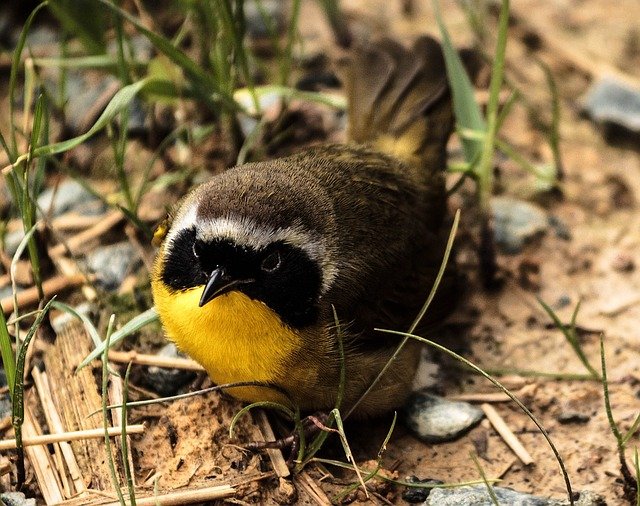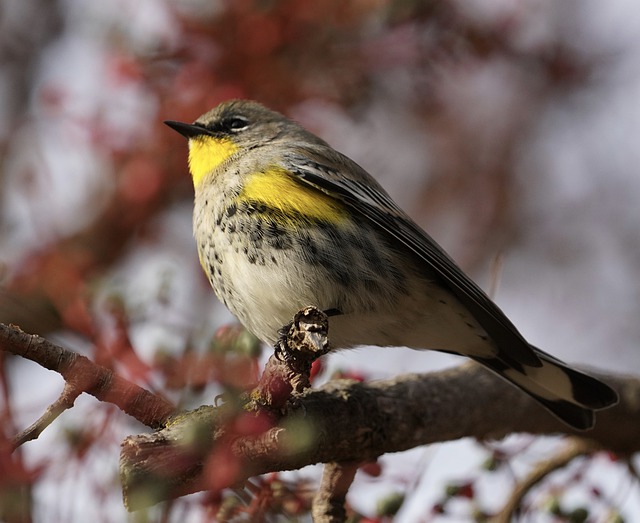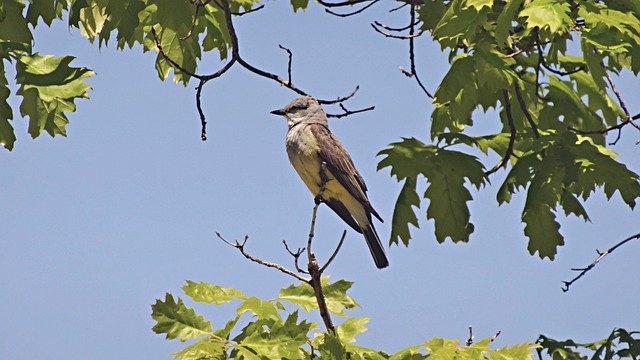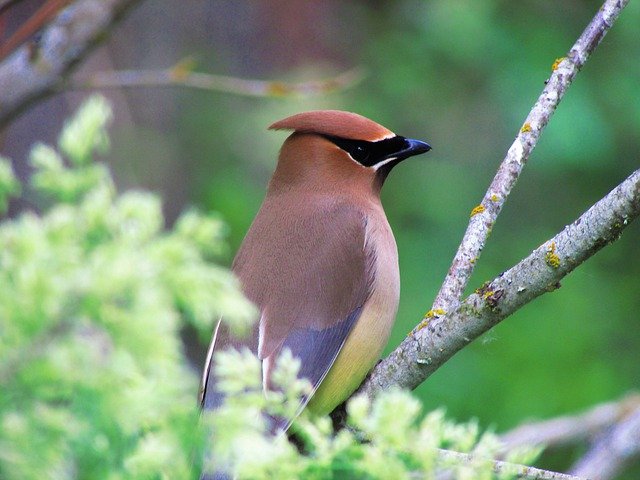Below I’ll be going over 9 unique yellow birds you can find scattered throughout Texas. The next time you head out on a hike or simply go on an adventure to capture some beautiful images of the wildlife, you can look out for the birds mentioned on this article.
- American Goldfinch
- Common Yellowthroat
- Lesser Goldfinch
- Female Summer Tanager
- Yellow Rumped Warbler
- Western Medowlark
- Western Kingbird
- Cedar Waxwing
- Great Crested Flycatcher
9 Yellow Birds in Texas
1. American Goldfinch (Spinus Tristis)

- Size: 11 – 13cm
- Weight: 11 – 20 grams
- Wingspan: 19 – 22cm
American goldfinches can be found in Texas throughout September – October and tend to leave around March – April.
These finches are recognised by their yellow, white and black plumage. Their wings are black and white, their forehead has a small black patch, their under tail is white with the remainder of the body a bright yellow color. Females are far less vibrant with hints of yellow but, mostly light brown in color.
As for where you can find American goldfinches in Texas, it will be around edges of forests and plains, around areas filled with brush and thistle plants.
American goldfinch tend to mainly eat seeds that come from the daisy composite family, seeds from weeds, from trees like birches and elm trees, buds, the occasional insect, maple sap and berries.
American goldfinches are known to live between 2 – 4 years in the wild and upto 9 years in captivity.
2. Common Yellowthroat (Geothlypis Trichas)

- Size: 11 – 14cm
- Weight: 11 – 15 grams
- Wingspan: 15 – 19cm
Common yellowthroats can be found in Texas all year round with the number increasing in the summer when more yellowthroats are migrating towards the state.
These yellowthroats are recognised by their mostly light brown/dirty yellow plumage from their head to their tail with their throat a bright yellow color. The males also have elements of black across their face whilst the females are mostly yellow with small elements of yellow on their tail and chin.
As for where you can find them, it will be around swamps, marshes, wet thickets, edges where they will often breed within wet marshes as well. They also nest within briars, moist brushy places, tangles of rank weeds and shrubbery along streams and overgrown fields.
Common yellowthroats are known to eat smaller insects like ants, spiders, beetles along with seeds and smaller fruits like berries.
These avians can live for around 11 years in the wild.
3. Lesser Goldfinch (Spinus Psaltria)

- Size: 9 – 12cm
- Weight: 8 – 11.5 grams
- Wingspan: 20 – 22cm
Lesser goldfinches are found in Texas all year round and are quite common there.
These finches are recognised by their black wings, back and upper head with the lower half of their body mostly yellow. A females plumage is similar but the darker elements are far duller.
Lesser goldfinches are often located in open brushy country, open woods, wooded streams, gardens that are generally semi-open as they like being around thickets and trees that are close to open weedy fields.
They are known to eat mostly seed with insects in the mix to make up for the protein where they specifically enjoy eating thistles, the buds on trees and berries too.
Lesser goldfinches tend to live for around 3 – 6 years in the wild and upto 10 years in captivity.
4. Female Scarlet Tanager (Piranga Rubra)

- Size: 15 – 18cm
- Weight: 25 – 35 grams
- Wingspan: 23 – 28cm
Summer tanagers can be found in Texas around April and May whilst in the autumn and winter months between September – December they will rarely be seen.
Female summer tanager’s are small, bright and yellow birds. Their male counterparts are completely red which shows the significant sexual dimorphism between the 2 genders.
You’ll find these birds hanging around open wooded areas, especially in areas with oaks.
As for what these tanagers eat, it includes mostly bees and wasps but they will occasionally go for smaller fruits and berries in bushes or trees.
These little birds are known to live between 3 – 5 years in the wild.
5. Yellow Rumped Warbler (Setophaga Coronata)

- Size: 12 – 14cm
- Weight: 12 – 13 grams
- Wingspan: 19 – 23cm
Yellow rumped warblers can be found in Texas throughout the winter months where they will arrive between September – October and leave around mid March.
These warblers are recognised by their gray and black wings, tail, back and head with a black mask like stroke across the eye, with yellow elements on the upper end of the wing, on the top and around the upper breast area. Females tend to be a gray/brown color whilst males are a little more vibrant.
Yellow rumped warblers are often found around coniferous forests, especially during the breeding season whilst in winter they can be found in open areas with fruiting shrubs.
As for what they eat, it includes insects and berries where the insects are caterpillars, wasps, grasshoppers, gnats, aphids, beetles, spiders with the berries including bayberry, juniper, wax myrtle, poison ivy, and others.
Warblers are known to live upto 10 years in the wild.
6. Western Medowlark (Sturnella Neglecta)

- Size: 16 – 26cm
- Weight: 88 – 116 grams
- Wingspan: 39 – 43cm
Western meadowlarks are all year round birds within Texas but the numbers do increase around winter.
They’re recognised by their yellow and black plumage on their breast, a black, white and brown spotted pattern on their wings along with its pointy gray beak acting as another one of its standout features. Females on the other hand are more brown and duller in color
These medowlarks can often be found spending their time in grasslands, cultivated fields, pastures, meadows and prairies.
Western medowlarks tend to eat insects and seeds with the insects including beetles, grasshoppers, crickets, caterpillars, ants, true bugs, spiders, snails, sowbug and waste grain seeds, which make up about one-third of their annual diet.
These medowlarks are known to live for around 10 years.
7. Western Kingbird (Tyrannus Verticalis)

- Size: 20 – 24cm
- Weight: 37 – 46 grams
- Wingspan: 38 – 41cm
Western Kingbirds are in Texas around summer where they arrive around April and tend to leave around September – October.
These birds are recognised by their gray head, back and wings, a pointy black beak with the lower half of their body mostly yellow. Females are duller in color than males and are also a lot more gray from head to breast too.
You’ll often find the western kingbird perched around open country, grasslands, dry savannas, valleys, lowlands, open farms, woodlands, agricultural fields and sagebrush.
Western kingbirds are known to eat mostly insects which include wasps, bees, beetles, grasshoppers, flies, true bugs, caterpillars, moths as well as other smaller fruits and berries.
These birds are known to live for around 6 years in the wild.
8. Cedar Waxwing (Bombycilla Cedrorum)

- Size: 15 – 18cm
- Weight: 25 – 35 grams
- Wingspan: 22 – 30cm
Cedar waxwings are in Texas around November and May in the winter.
They’re recognised by their plumage that have elements of yellow across their body which can be found on their tail and breast with the remainder of their body a gradient brownish/gray color, a mask shaped black element on their face and a red strip on their wings. Females look very similar to males with main tell tail sign being darker coloration on a males chin.
Cedar waxwing can be found around open woodlands, fruiting trees, forest edges, streamsides, overgrown fields, edges of swamps, suburban yards and orchards. In the winter months they can sometimes be seen spending their time in towns.
These avians are known to mostly eat fruits and berries with the ones they feed on most often being juniper, dogwood, and wild cherries. They also drink the juices from flowers and eat a variety of small insects like beetles, ants, caterpillars etc.
As for their lifespan, they are often known to live for 8 years in wild.
9. Great Crested Flycatcher (Myiarchus Crinitus)

- Size: 17 – 21cm
- Weight: 27 – 40 grams
- Wingspan: 32 – 35cm
These birds can be spotted in Texas all year round although they are far easier to spot in the summer months between April – October.
Great crested flycatchers are recognised by their brown mohawk like head feathers, brown feathers, gray neck and yellow breast. Females are very similar looking to the males.
These flycatchers are located around deciduous or mixed-deciduous woodlands like a semi-open canopy, forest edge and urban areas with large trees.
They can eat a variety of food sources with insects being their main grub where they will often hunt them in the air. Lizards, berries among other fruits are also eaten by these little birds.
Great crested flycatchers are known to live between 2 – 10 years.
Amhil Khan, a dedicated nature enthusiast and the founder of BirdsOfTheWild.com, is a passionate advocate for the captivating world of avian wonders. With a deep-seated curiosity about the intricate lives of birds, Amhil’s journey began as a fascination and has evolved into a mission to inspire others to appreciate and protect these magnificent creatures.
Amhil’s love for birds led to the creation of Birds of the Wild, a platform where his expertise in ornithology, coupled with his captivating storytelling, provides readers with an immersive and educational experience. Through his lens and words, he captures the essence of birds in their natural habitats, offering a glimpse into their behaviors, migrations, and the ecosystems they inhabit.
